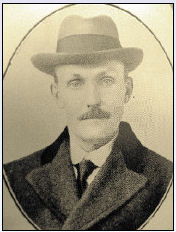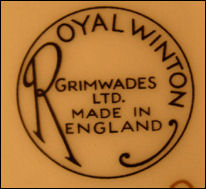Historian Fred Hughes writes....
On 26th January 1931 the pottery manufacturer Leonard Grimwade
was killed in a road accident in Hassall Street Newcastle when the car he
was driving collided with a bus.
“Grimwade was an active 66 year-old at the time,” Potteries historian
Steve Birks recounts. “He was the chairman and managing director of
several manufactories under the brand name of Royal Winton Pottery. The
factory closed some time ago but the fine building can still be seen in
Stoke Road just north of the railway bridge.”

Winton Pottery, Stoke
Road
"Messrs. Grimwade Brothers established their Winton Pottery (Stoke) in
about 1886. A wide range of useful and decorative earthenware was
produced."
From: Jewitts 'Ceramic Art of Great
Britain 1800-1900.
Grimwade came to the Potteries from Ipswich as a decorator/modeller rising
to create a massive business in partnership with his brothers Edward and
Sydney on a 2 acre site near the station.
“The factory opened in 1897 by which time Leonard was a Hanley Borough
Councillor and a member of North Staffs Chamber of Commerce,” Steve
continues.
“From this position he was made secretary of the newly assembled
Committee for the Promotion of Federation in 1907. The president was the
Duke of Sutherland; Cecil Wedgwood was the chairman and Thomas Twyford
was the treasurer. As secretary Grimwade also took on the role as
publicity agent making sure that all those who had influence in the
Potteries became signed-up members including 3 mayors, 5 aldermen, 15
magistrates together with leaders of industry and commerce. In this role
he worked tirelessly.”

Leonard Grimwade
|
Grimwade gathered evidence from far and wide to support the federation
cause. He seemed to be everywhere, travelling around the country to
see what benefits other local authorities enjoyed under single
management. He noted comparisons with Nottingham, a similar size
district and population, and proved unquestionably that Nottingham’s
transport maintenance costs were half that of the Potteries towns put
together. He began to influence his colleagues and told them that
instead of a number of separate companies federation would produce a
Nottingham-style system bringing Tunstall and Fenton within 20 minutes
of each other at a fare of just one penny.
This was Grimwade at his best for he was a dazzling salesman. His
assertions that federation would result in more efficient management
and economy were extremely convincing. He promoted media hype to a
wide audience by printing sensationalised copies of pro-federation
speeches made by the Duke of Sutherland and other federation leaders
which he distributed to 30,000 ratepayers. He also took opinions from
160 leading citizens which he copied into a remarkable theatrical
Opinion Book.
“Grimwade was a spin doctor long before Peter
Mandelson and Alistair Campbell were twinkles in Tony Blair’s eyes,”
grins Steve. “And there’s no doubt he was good at it. But long
absences were disadvantageous to his business. Soon after his death
his factories began to decline even though the Winton brand
continued for some years. The great Grimwade relic nonetheless is
the superb factory building in Stoke Road. This was the flagship of
a self-made manufacturer and in his time there was none better than
Leonard Grimwade.”
|

Royal Winton
backstamp used on some of the
Grimwades ware
Sandra Booth is a director of Winton Property, while the owner of the
Winton building today is the landscape garden designer and businessman
William Podmore OBE of Consall Hall.
“Mr Podmore bought Winton Pottery in 1965 as a commercial property
investment,” Sandra tells me. “We’re very fortunate to have the detailed
notes he made of the building when he first saw it. It must have been a
remarkable step into the past.”
Mr Podmore, a historian of some respect, recalls his first view.
“The building was constructed in good quality red brick with stone
features,” he details. “The foundation stone is dated 1891. But when I
added another storey to the building I removed it. In fact the whole
central gable was removed to Consall where it was used as a garden
feature. The pottery itself had been much altered between 1918 and 1939;
part had been made into a restaurant; a ground floor corner into a
factory shop. The site apparently had been formerly occupied by a row of
terraced worker’s cottages built around 1850. A good number of these
were demolished by Grimwade himself to build his factory.
The remaining derelict houses I removed in 1965. I added new offices and
a roof car park having cleared much debris away. But the factory was a
typical Victorian pottery and suggestive of a lost age. The original
factory layout was good when little machinery was required. But as
output increased short term unsatisfactory solutions were imposed. In
post-war Britain labour changes increased mechanism and management
simply failed to adapt.”
In the late 1920’s Winton amalgamated and after Grimwade’s fatal accident
in 1931 it was taken under the control of a managing director James Plant.
After Plant’s death in 1962 it was absorbed into the Howard Pottery Group
and closed.
Mr Podmore, now age 90, recalls the factory in 1965.
“It was evident the company had slowly faded after the war; very little
had been done to modernise it. The workrooms and offices bore a gloomy
resemblance to the Dickensian period,” he says.
A reminder from the past, you could say, nudging
our elbow to what’s happening now.

click the "contents"
button to get back to the main index
